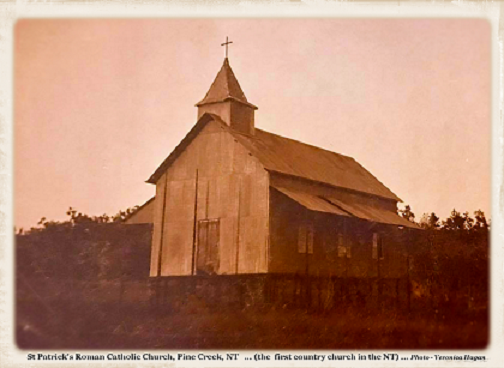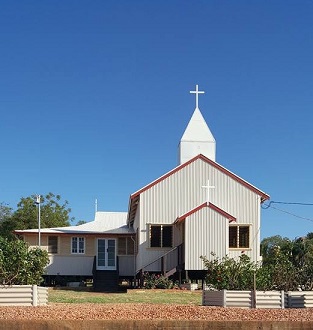DO YOU KNOW ABOUT THE MSC HISTORY IN TENNANT CREEK, NT?
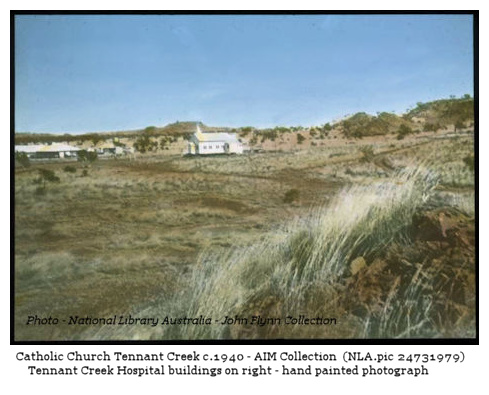
Googling turns up some news and history items.
During the 1930s Tennant Creek was in the midst of a gold mining boom. In 1934, to cater to the growing non-Aboriginal population, approval was granted for the establishment of a Catholic Mission Station in the Tennant Creek area.
The church building was originally constructed in 1904 in Pine Creek, which is 760 km north of Tennant Creek, but by the mid-1930s the church had fallen into disrepair. In 1935 Reverend Father W.J. Dew, M.S.C. of the Darwin Parish, was asked by Bishop Francis Xavier Gsell to assess the needs of the Tennant Creek parishioners, who numbered approximately 300. Dew later wrote:
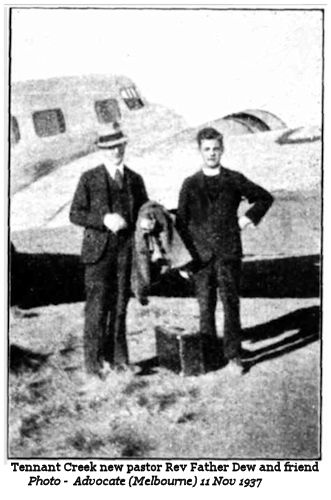
I was appointed to Tennant Creek in 1935. I went to Darwin in 1936 and discussed the whole situation with Monsignor Gsell. He suggested me taking the P.C. (Pine Creek) church to T.C. (Tennant Creek). So there and then I arranged for Brother Andrew Smith M.S.C. (skipper of our Mission Boat serving Bathurst Island and Port Keats) to come with me to Pine Creek for a fortnight and managed in that time to dismantle the Church that was there.
Father Dew undertook fundraising for the project in Adelaide and was reportedly frustrated by the lack of generosity he encountered there, particularly on one occasion when a wealthy woman replied to his request for a donation by simply saying, "Give my love to the miners".
The dismantled church was railed to Birdum and then trucked the remaining distance. The trucks carrying the dismantled church were caught in floods at Daly Waters and parts of the loads were left on the roadside. Spread out along the route for some time, it became known as the "longest church in Australia". While the church was reconstructed, mass was held "in the residence of some local Catholic". The relocation was expensive, and by the time it was opened on 21 November 1937 by Bishop Raible had cost "many hundreds of pounds". The church was reconstructed in a different layout that in its original location. An office and verandas were later built "on two sides to serve as accommodation for the priest".
During World War II the church became a social centre for troops travelling the north-south road. Father Dew stayed in Tennant Creek throughout the war and was Chaplain to the 55 Australian Camp Hospital in 1944.
Rev. Father Wilfred Dew had been a science master and was very fond of books. This young man was appointed to Tennant Creek in 1935, after only ten years of teaching, and evangelised the mining community. He had abandoned the comfort of a professor’s chair to plunge into the bush with neither church nor presbytery and only a car for his home, and his ministry to support his spirit.
For the first six months mass was celebrated in the homes of some parishioners. The dining table was pushed to the end of the room, clothes were removed from nails, and the best was made of the circumstances. The small congregation knelt on the ant-bed floor (possibly Weber’s residence at the Rising Sun Mine). Also Scott’s Hall, next to the Tennant Creek Hotel was made available, but this was unsuitable as the dance which was held there on Saturday nights left the hall in confusion.
Father Dew designed the building which was re-built differently then had been at Pine Creek, which he described as virtually a 60 foot by 20 foot hay shed. The building comprised of the Church and Sacristy, which was the office and Confessional, front and inside verandas with a bathroom and windmills, one to pump rain water to the overhead tank. There were three water tanks on site providing a total of 5,400 gallons. Wooden louvres were imported from Queensland whilst all church and residence furniture was brought up from Adelaide. Father Dew designed the church seats and alter which were made to order. Windows, wall and ceiling lining, guttering and all plumbing was also purchased interstate. A wind driven generator provided electricity by charging batteries. The majority of the costs for the building were borne by promoters from the southern states plus locally by the Dwyer and Weaber families and also T Kelley. The relocation of the church was expensive, the overall cost was over £3,000.
“The Longest Church in Australia” In the early 1930’s Tennant Creek was granted approval for the establishment of a Catholic Mission Station. Father Moloney M.S.C. came from Alice Springs at irregular occasions to celebrate mass.
The Reverend Father Wilfred J. Dew, Missionaries of the Sacred Heart (M.S.C.) of the Darwin Parish, was asked by Bishop Francis Xavier Gsell to assess the needs of the Tennant Creek parishioners, who numbered approximately 300.
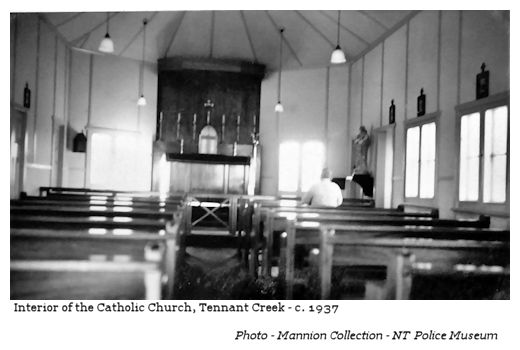
Northern Standard (Darwin NT 1921:1955) – Tuesday 29th September 1936
The Reverend Father Dew cleared the town this morning in his motor van for his headquarters at Tennant Creek. Brother A. A. Smith of the mission staff is making the journey with the Reverend gentleman to Pine Creek, where the Catholic Church at the mining township is to be pulled down and removed to Tennant Creek. The materials will be trucked by rail to Birdum and then by motor truck to the site of re-erection.
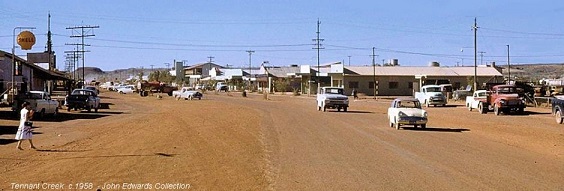
So from an the abandoned mining centre of Pine Creek, no less than four hundred and fifty miles distant, Father Dew brought a church whose iron framework was dismantled in two weeks.
It was then railed from Pine Creek to Birdum (Larrimah) and the Tennant Creek trucking firm of Dave Baldocks carried out the move the remaining distance, in conjunction with Snowy Renfrey.
The trucks carrying the dismantled church were caught in flood waters at Daly Waters and parts of the load were unloaded when the trucks became bogged and left by the roadside, some being washed away.
Because the building was spread out along the route between Pine Creek and Tennant Creek, some four hundred and fifty miles for quite some time, it became affectionately known by locals as the:- “longest church in Australia”.
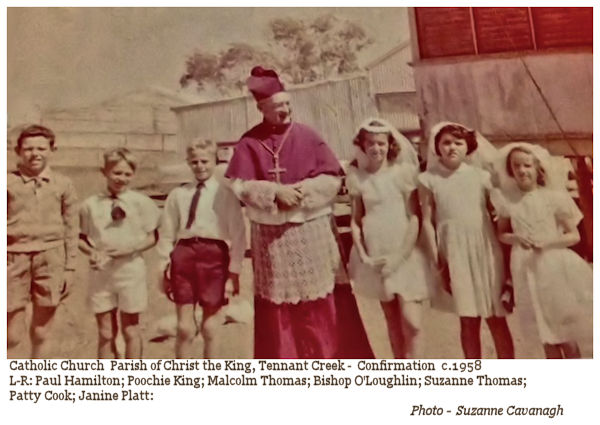
Parish Priests during the 40 years of MSC presence:
1935 – 45 … Rev. Fr. Wilfred J Dew MSC
1945-46 … Rev. Fr. A Guest MSC
1947-51 … Rev. Fr. John Cosgrove MSC
1951-54 … Rev. Fr. Dallas J Cox MSC
1954-55 … Rev Fr. A.J. Collins MSC (relief)
1955-56 … Rev. Fr. Dallas J Cox MSC
1956-57 … Rev. Fr. Fred Mordaunt MSC
1957-70 … Rev. Fr. George Vincent Taylor MSC
1970-71 … Rev. Fr. Maurice McPhillamy MSC
1972-73 … Rev. Fr. John Fallon MSC
1973-74 … Rev. Fr. John O’Carrigan MSC
